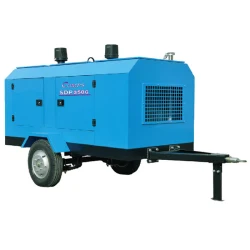Components of an air compressor
2024-01-02
An air compressor is a mechanical device that converts power (usually from an electric motor, diesel engine, or gasoline engine) into potential energy stored in compressed air. This compressed air can be used in various applications, ranging from powering pneumatic tools to inflating tires, operating machinery, and more. Air compressors are widely used in both industrial and residential settings. Here are some key features and components of an air compressor:
Key Components:
1. Compressor Pump:
- The compressor pump is the core component that pressurizes the air. It typically consists of one or more cylinders and pistons that draw in, compress, and discharge air.
2. Motor or Engine:
- The motor (electric) or engine (diesel or gasoline) provides the power to drive the compressor pump. The motor or engine's horsepower rating determines the compressor's capacity and performance.
3. Tank:
- The compressed air is stored in a tank, acting as a reservoir. This allows the compressor to build up pressure and store a supply of compressed air for immediate use when needed.
4. Pressure Switch:
- The pressure switch monitors the air pressure in the tank. When the pressure drops below a preset level, the switch activates the motor or engine to start the compressor pump. Once the pressure reaches the upper limit, the switch turns off the motor or engine.
5. Pressure Gauge:
- The pressure gauge displays the current air pressure inside the tank. It helps users monitor the compressor's performance and ensures that it operates within safe pressure limits.
6. Regulator:
- The regulator controls the air pressure delivered from the tank to the connected tools or equipment. It allows users to adjust and set the desired working pressure for specific applications.
7. Safety Valve:
- The safety valve is a crucial safety feature that releases excess pressure if the pressure switch fails or malfunctions. It prevents the tank from overpressurizing, reducing the risk of accidents.
8. Drain Valve:
- The drain valve is used to release accumulated moisture from the air tank. This prevents corrosion and ensures the longevity of the tank.
Types of Air Compressors:
1. Reciprocating (Piston) Compressors:
- Feature one or more pistons inside cylinders that compress air. They are available in single-stage and two-stage configurations.
2. Rotary Screw Compressors:
- Use helical screws to compress air. They are known for their continuous operation and are often used in industrial applications.
3. Centrifugal Compressors:
- Operate by accelerating air through a rotating impeller. These are typically used for large-scale industrial processes.
4. Scroll Compressors:
- Use a pair of interleaving spiral elements to compress air. They are often compact and used in smaller applications.
Common Applications:
- Powering Pneumatic Tools: Air compressors are commonly used in construction, automotive repair, and manufacturing to operate tools such as nail guns, impact wrenches, and paint sprayers.
- Inflating Tires: Portable air compressors are often used to inflate car, bicycle, and motorcycle tires.
- Industrial Processes: Air compressors play a vital role in various industrial processes, including manufacturing, packaging, and material handling.
- HVAC Systems: Air compressors are used in air conditioning and refrigeration systems to circulate refrigerant and maintain proper pressures.
When selecting an air compressor, factors such as the required pressure, airflow (measured in cubic feet per minute or CFM), and the intended applications should be considered. Regular maintenance, including checking for air leaks and draining moisture from the tank, is crucial to ensure the efficient and safe operation of the air compressor.



